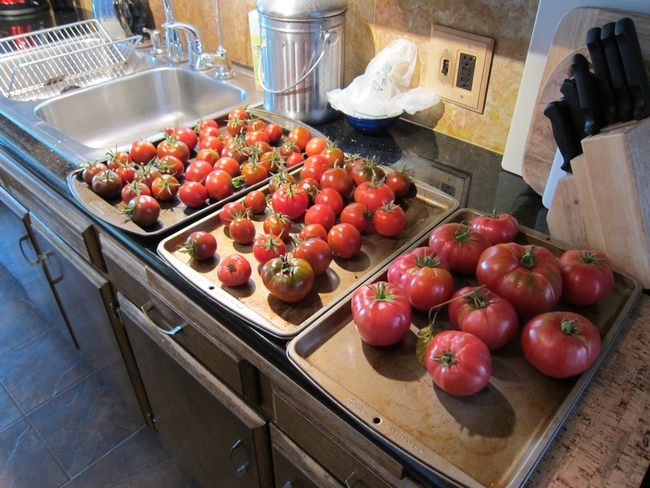Rooted in Richmond...The Month of September in a Small West County Garden
As I write this blog entry the view out my window shows pendulous grey clouds and rain. Our first storm of the season has rolled in and dropped about ¾ of an inch of rain. Mother Nature’s timing couldn’t be any better- Merritt College’s Fall Plant Sale was last weekend and I went a little native happy. I purchased a lupine (Lupinus arboreus), a Mimulus hybrid that has multi-colored flowers, and a Seaside Daisy (Erigeron glaucus) just to name a few. Happily, I got all of my natives in the ground before the first of the rain started to fall on Monday. I also transplanted four roses this weekend and I am sure they are appreciating the gentle watering this storm has provided.
Right now in my garden it is the season of in-betweens. Pretty much all of my summer vegetables have succumbed. My spindly beans were pulled weeks ago, and my squash vines have pretty much shriveled up. I have one sad little cucumber left on the vine, and my basil has given up the ghost. But my tomatoes have finally come into their own, and this week I set a new harvest record for myself of 15 pounds in one day! I planted twelve different types of heirloom tomatoes last April, and now I am floating in a sea of red. Sauce, dried tomatoes, frozen tomatoes, salsa, pizza, etc.- I am finding creative ways to include tomato dishes in every meal. Out of all of the heirlooms tomatoes I planted, three far outperformed the rest: the Chianti Rose, the Carbon, and the Paul Robeson. This is especially exciting to me because last year my tomato crop was meager. It was the first year I had planted directly into the ground (rather than raised beds) and the small yield reflected the poor preparation of my soil. After spending a winter adding compost, manure, and growing a cover crop, it is obvious that I have improved the macro-nutrient load of my soil.
So, while one season’s worth of crops is pretty much done, I haven’t planted anything new. There is a reason for this besides just the usual exhaustion that hits hardcore summer gardeners at this time of the year. I am not planting a winter vegetable crop this year. Whew, I feel better now that I have admitted it out loud. For awhile I felt guilty about this decision because it seems like such a huge waste of the Bay Area’s great extended growing season. But, I have come to understand that there is a certain wisdom in allowing things to lay fallow. Over the past couple of years I have experimented with different ways to take care of my soil- to feed it after it is done feeding me. I have grown favas, I have grown vetch, I have chopped and dropped and I have tilled into the soil. Last year, I took my cover crop practice to another level. I grew a mixture of legumes and oats, and rather than chopping them all down at once, I cut them down methodically. As I got ready to plant in certain areas, I would chop down the plants in that area, plant the seeds or plants and then use the chopped portions as a green mulch. In this way, I was able to stagger the nitrogen input into the soil, I allowed some of the cover crops to flower which attracted tons of beneficial insects, and I left my pest insects something to eat besides my baby seedlings.
As with any experiment, this method had its drawbacks as well as its benefits. By the time I got around to cutting back some of the cover crop, the stems had gotten very woody and as a result were slow to break down. Also, I was unprepared for how much the green mulch would shrink in the sun, thereby leaving many areas of soil uncovered. I am also curious as to what degree my vegetable seedlings had to compete with the established cover crops around them for sunlight, water, and nutrients.
This year I will be trying yet another approach. As I refine my technique, one of the important considerations is cost both for me and for the environment. While bringing in truckloads of compost can really improve the soil, it can be prohibitively expensive. Also, you have to consider questions about where the compost comes from and what types of microbes it introduces to your yard. So, this year I am keeping it REALLY local. I am bringing in free horse manure from down the street. I will be adding my own home-made compost. And, I will be allowing my chickens to have a field day with all of the yummy things they find in both the manure and the compost. I am not going to do a cover crop this year because I haven’t thought of a good way to combine chickens with this process. It seems to me that they would think the seeds I am putting in the ground are special treats for them, and then if any of the seeds managed to germinate, well, you know what would happen! If anyone has any information on how to combine chickens with cover-cropping I would love to hear about it.
That’s it for now. Best of luck with whatever your fall gardening chores are!








